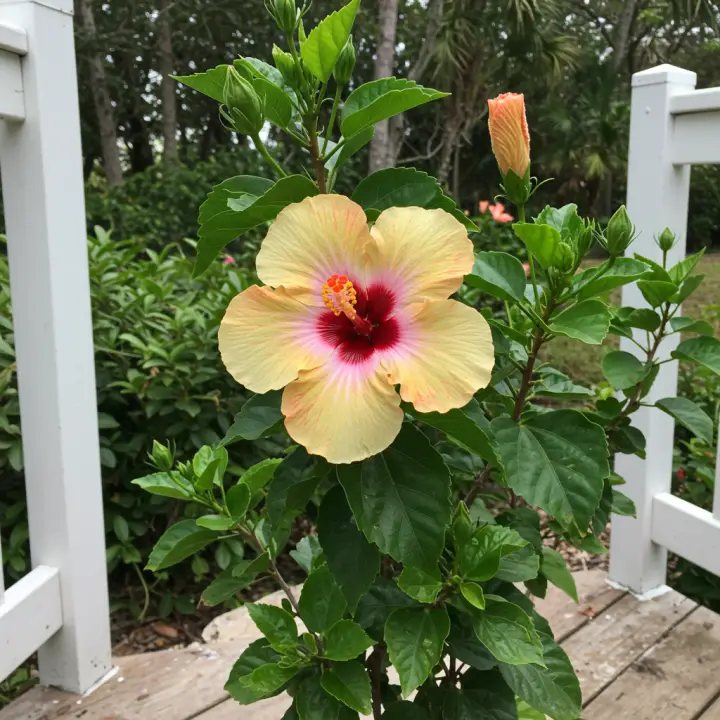This comprehensive guide explores the best time for hibiscus planting in Florida, covering various aspects from ideal planting conditions and soil preparation to ongoing care and maintenance for maximizing vibrant, tropical blooms.

Introduction: A Burst of Tropical Color in the Sunshine State
Hibiscus, with its vibrant and showy flowers, adds a touch of tropical paradise to any Florida landscape. Whether you’re envisioning a stunning hedge, a vibrant focal point in your garden, or a cheerful container plant on your patio, understanding the nuances of hibiscus planting in Florida’s unique climate is crucial for success. This guide provides a thorough exploration of how to successfully cultivate these beautiful plants, ensuring they thrive and reward you with a breathtaking display of color.
Choosing the Right Hibiscus for Florida
Before diving into planting techniques, it’s essential to select the right hibiscus variety for Florida’s climate. The most common varieties include:
Tropical Hibiscus (Hibiscus rosa-sinensis): These are the classic large-flowered hibiscus with a wide range of colors. They thrive in warm, humid conditions and are somewhat sensitive to cold temperatures.
Hardy Hibiscus (Hibiscus moscheutos): These varieties are more cold-tolerant and can withstand milder Florida winters. They feature large, dinner-plate-sized blooms.
Native Hibiscus (e.g., Hibiscus coccineus): These varieties are adapted to Florida’s environment and are generally low-maintenance options.
Understanding Florida’s Climate Zones
Florida’s diverse climate plays a key role in hibiscus planting. The state is broadly divided into three zones:
North Florida: Experiences cooler winters and requires more cold-hardy hibiscus varieties.
Central Florida: Offers a transitional climate, suitable for both tropical and hardy hibiscus with some winter protection for tropical varieties.
South Florida: Enjoys a warm, tropical climate ideal for a wide range of hibiscus varieties.
Best Time for Hibiscus Planting in Florida
The optimal time for hibiscus planting in Florida depends on your location and the specific variety.
South Florida: Hibiscus can be planted year-round due to the consistently warm temperatures. However, spring and fall are generally preferred for optimal root establishment.
Central Florida: Spring (March-May) and fall (September-October) are the best times to plant hibiscus. These periods offer milder temperatures and sufficient rainfall for healthy growth.
* North Florida: Spring, after the last frost (typically April-May), is the ideal time to plant hibiscus, allowing the plant to establish itself before the onset of cooler temperatures.
Soil Preparation and Planting Techniques
Hibiscus thrives in well-draining, fertile soil. Follow these steps for successful planting:
1. Choose a sunny location: Hibiscus plants need at least 6-8 hours of direct sunlight per day for optimal flowering.
2. Amend the soil: Incorporate organic matter like compost or peat moss to improve drainage and fertility.
3. Dig a hole: The hole should be twice as wide and slightly deeper than the root ball.
4. Place the hibiscus plant: Carefully position the plant in the hole, ensuring the top of the root ball is level with the ground.
5. Backfill the hole: Gently fill the hole with amended soil, firmly tamping down to eliminate air pockets.
6. Water thoroughly: Deep watering after planting encourages root establishment.
Ongoing Care and Maintenance
Watering
Hibiscus require regular watering, particularly during dry periods. Ensure the soil remains consistently moist, but not waterlogged.
Fertilizing
Regular fertilization promotes healthy growth and abundant blooms. Use a balanced fertilizer specifically formulated for flowering plants.
Pruning
Pruning helps maintain the shape of the hibiscus plant and encourages bushier growth. Prune in late winter or early spring before new growth emerges.
Pest and Disease Control
Monitor your hibiscus plants for common pests like aphids, whiteflies, and spider mites. Address any infestations promptly with appropriate insecticides or horticultural oils.
Winter Protection
In North and Central Florida, protect tropical hibiscus from frost damage by covering them with blankets or bringing potted plants indoors during cold snaps.
FAQs – Hibiscus Planting in Florida
Q: How often should I water my hibiscus plant?
A: Water your hibiscus deeply whenever the top inch of soil feels dry. Frequency will depend on the weather, but during hot, dry periods, you may need to water daily or every other day.
Q: What type of fertilizer should I use for hibiscus?
A: A balanced, slow-release fertilizer with a higher potassium content is ideal for promoting vibrant blooms. Follow the package directions for application rates.
Q: Why are my hibiscus leaves turning yellow?
A: Yellowing leaves can indicate several issues, including overwatering, underwatering, nutrient deficiencies, or pest infestations. Check the soil moisture and inspect the plant for pests to determine the cause.
Q: Can I grow hibiscus in a container?
A: Yes, hibiscus can be grown successfully in containers. Choose a large pot with good drainage and use a high-quality potting mix.
Q: How do I protect my hibiscus from frost?
A: Cover your hibiscus with blankets or burlap during frost warnings. For potted hibiscus, bring them indoors or into a sheltered area.
Conclusion
Hibiscus planting in Florida offers a rewarding opportunity to add vibrant, tropical beauty to your landscape. By following these tips for proper planting, care, and maintenance, you can enjoy stunning hibiscus blooms throughout the year, transforming your garden into a colorful oasis. Choosing the correct variety for your specific climate zone and understanding the plant’s needs, ensures your hibiscus plants thrive and reward you with their vibrant display, capturing the essence of Florida’s tropical charm.

